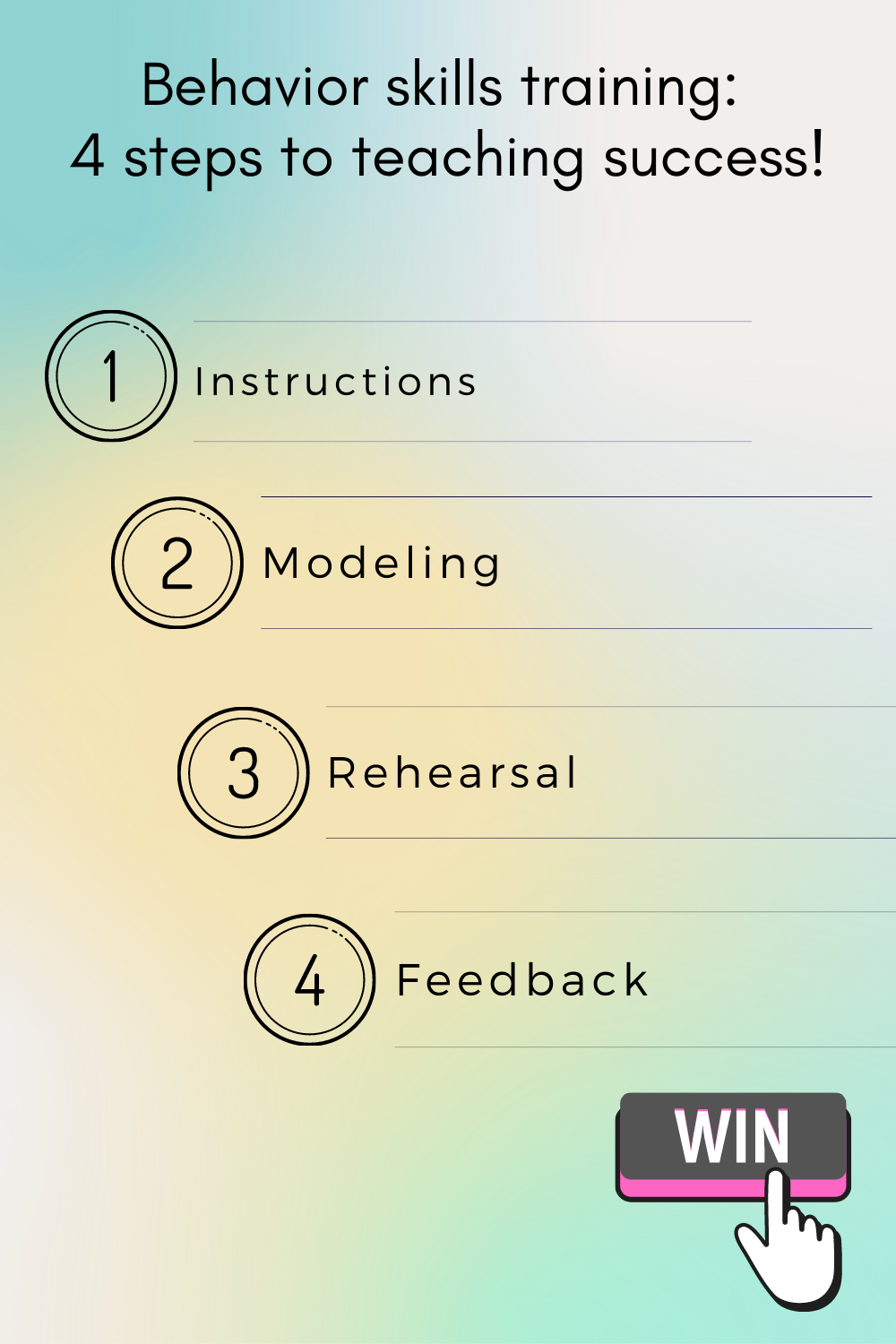Behavior skills training (BST) has 4 key steps: (1) instructions; (2) modeling; (3) rehearsal; and (4) feedback.
As behavior analysts, we know how to use this, right? We can do the 4 steps in our sleep. But what about the families we work with? Are the parents able to use the steps of BST to address whatever every day situations arise?
One of the amazing moms I get to work with in our Confident Parenting Framework was having issues first thing in the morning. Every day. No one wants to start their day off with problem behaviors and struggling to connect to their kids. So we decided to create a whole new morning routine to help all members of the family start the day off on the right foot.
We talked through the right steps for their family and created a new, simple morning routine. Voila! All problems solved! No? Not yet?

How do we teach the children this new routine? How do we help them be successful? Enter Behavior Skills Training. Here’s a little summary of what that looked like:
- Instructions (including rationale): “Mornings have not been going very smoothly so we are going to start something new to help everyone feel better in the mornings! Here is a list of steps with pictures. (Read off each step).”
- Modeling: “Now I’m going to show you how to do all the steps. You get to be mommy and I get to be daughter.” Mom goes in daughter’s room (maybe even in her bed) and dramatically pretends to wake up, check the new routine visual schedule and go through all the steps.
- Rehearsal: “Now you watched me do it. Your turn to show me what all the steps will look like in the morning. I’m back to being mommy and you get to be the daughter this time.”
- Feedback: During rehearsal, prompt to do the correct steps. After, give specific feedback, “I love how you checked your schedule and did the new routine steps in order!” In real life the next morning, give prompts to remember how we acted it out yesterday and specific praise. No criticism, prompting to help get it right andn praise that tells the child exactly what she did well.
And guess what happened. It worked! They practiced in the afternoons a few times and soon mornings were running smoothly combined with positive reinforcement for completing the routine nicely.
As parents, we often stop at step 1. We give instructions and we just expect our kids to know how to do the rest and follow through. We tell them to do the thing, then we expect them to do the thing. But what about teaching them to do the thing?
- Tell how to do the thing and why we need the thing.
- Show how to do the thing.
- Have them practice how to do the thing.
- Tell them how well they did the thing and help them be successful doing the thing by prompting.
So back to this awesome mom who successfully used BST to save her mornings. Another day we start talking about something much more challenging, self-regulation. We were trying to give her daughter some options and some independence in practicing different activities to use when her body just wasn’t feeling right. Does she want to try things like deep breaths and sitting calmly? Or does she want to try some big movements and exercise like jumping jacks or running? Does she want to talk to mom about what’s going on or does she need a little personal space? These are really hard, complex things that this great mom is trying to give to her daughter as choices and options. We made a list of things that work for her daughter, things ilke- sensory ideas, calm down strategies, and ‘I’ statements to help her communicate her wants and needs.
How on earth do we begin to teach each of these tools to her daughter? How do we teach her to choose one from a visual choice board when she needs them? Where do we start. Here’s what that conversation looked like:
Me: “Remember how you taught the new morning routine?”
Mom: “Yes.”
Me: “And did that work?”
Mom: “Yes.”
Me: “Did you know you can use those same 4 steps to teach complex things like self-regulation and self-management strategies?”
Mom: “Really?!”
This one isn’t going to happen in 2 quick afternoon practice sessions. Teaching and practicing self-regulation skills is something that we will be working on for a very long time. But doing it by using behavior skills training makes it more effective and more efficient.
Parents can use the 4 steps of BST every single day. They can do it quickly and make it fun once they get the hang of it. But when we say things like “multi-component intervention package of Behavior Skills Training” it sounds super overwhelming.
Parents- try the 4 steps to teach your kids to do the thing. Do all 4 steps. In order. Don’t stop at just telling your kids to do the thing. Need help brainstorming this? Book a free brainstorming session with yours truly here: https://www.parentingwithaba.org/coaching/
Behavior analysts- empower your families with this super successful behavior tool of BST. Make it easier for them. Join us for our nex CE event inside the Parenting with ABA CE Membership: “Making BST Less Daunting for Parents”. Enrollment for this month takes place June 16-18 only. Get on the waitlist for it here: https://www.parentingwithaba.org/ce-membership-sign-up/

Recent Comments